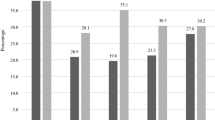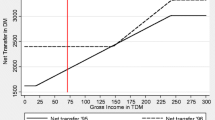Abstract.
This paper presents an analysis of the effects of Canadian child benefit policies on fertility and female labor supply. Canada has adopted a variety of child benefit policies since 1918 that are incorporated into an economic model of fertility. This model is estimated and tested with time series data on fertility, female labor force participation, female wages, male incomes, female education, and child benefits. Cointegration methods are employed to accommodate problems of nonstationarity and endogeneity that characterize time series models of fertility and female labor supply. Two cointegrating relations are found, and these are identified as a fertility relation and a female labor supply function. All economic variables, including child benefits, have statistically significant and appropriately signed coefficients. The estimates are used to evaluate the effects of policy and other economic changes on fertility.
Similar content being viewed by others
References
Tilak Abeysinghe (1993) ArticleTitle“Time Cost, Relative Income, And Fertility In Canada” Journal of Population Economics 6 189–198
Roy Bailey Marcus Chambers (1993) ArticleTitle“Long Term Demographic Interactions In Precensus England” Journal of the Royal Statistical Society A 156 339–362
Paul Beaudry Thomas Lemieux Daniel Parent (2000) ArticleTitle“What is Happening in the Youth Labor Market in Canada” Canadian Public Policy 36 S59–S83
Gary Becker (1981) A Treatise on the Family Harvard University Press Cambridge, MA
William Butz Michael Ward (1979) ArticleTitle“The Emergence Of Countercyclical Fertility” American Economic Review 69 318–328
Yin-Wong Cheung Kong Lai (1993) ArticleTitle“Finite-Sample Sizes of Johansen’s Likelihood Ratio Tests for Conintegration” Oxford Bulletin of Economics and Statistics 55 13–28
David Dickey Sastry Pantula (1987) ArticleTitle“Determining the Order of Differencing in Autoregressive Processes” Journal of Business and Economic Statistics 5 455–461
Barbara Devaney (1983) ArticleTitle“An Analysis Of Variations In US Fertility And Female Labor Force Participation Trends” Demography 20 147–161
John Ermisch (1988) ArticleTitle“Econometric Analysis Of Birth Rate Dynamics In Britain” Journal of Human Resources 23 563–576
Jesus Gonzalo (1994) ArticleTitle“Five Alternative Methods of Estimating Long-Run Equilibrium Relationships” Journal of Econometrics 60 203–233
Hendrik Hansen Katerina Juselius (1995) CATS in RATS: Cointegration Analysis of Time Series. Estima Evanston, Illinois
Douglas Hyatt William Milne (1991) ArticleTitle“Countercyclical Fertility in Canada: Some Empirical Results” Canadian Studies in Population 18 1–16
Johansen Soren (1991) ArticleTitle“Estimation and Hypothesis Testing of Cointegrating Vectors in Gaussian Vector Autoregressive Models” Econometrica 59 1551–1580
Soren Johansen Katerina Juselius (1994) ArticleTitle“Identification of the Long-Run and the Short-Run Structure: An Application to the ISLM Model” Journal of Econometrics 63 7–36
Soren Johansen (1995) Likelihood Based Inference in Cointegrated Vector Autoregressive Models Oxford University Press Oxford
Soren Johansen (1997) ArticleTitle“Likelihood Analysis of the I(2) Model” Scandinavian Journal of Statistics 24 433–462
Evelyn Lehrer Marc Nerlove (1986) ArticleTitle“Female Labor Force Behavior and Fertility in the United States” American Review of Sociology 12 181–204
Diane Macunovich (1996) ArticleTitle“Relative Income And Price Of Time: Exploring Their Effects On US Fertility And Female Labor Force Participation” Population and Development Review 22(suppl) 223–257
Robert. McNown (2003) ArticleTitle“A Cointegration Model of Age-Specific Fertility and Female Labor Supply in the United States” Southern Economic Journal 70 344–358
Robert McNown Sameer Rajbhandary (2003) ArticleTitle“Time Series Analysis of Fertility and Female Labor Market Behavior” Journal of Population Economics 16 501–523
Abul Masih Rumi Masih (1999) ArticleTitle“Is a Significant Socio-Economic Structural Change a Prerequisite of ‘Initial’ Fertility Decline in The LDCs Evidence from Thailand Based on a Multivariate Cointegration/Vector Error Correction Modelling Approach” Journal of Population Economics 12 463–487
Anders Rahbek Hans Christian Kongsted Clara Jørgensen (1999) ArticleTitle“Trend Stationarity in the I(2) Cointegration Model” Journal of Econometrics 90 265–289
Cristobal Ridao-Cano Robert McNown (2003) The Effect of Tax-Benefit Policies on Fertility and Labor Force Participation in the United States University of Colorado Mimeo
Morton Shapiro (1988) ArticleTitle“Socio-Economic Effects Of Relative Income And Relative Cohort Size” Social Science Research 17 362–383
Alison Sprague (1988) ArticleTitle“Post-War Fertility And Female Labor Force Participation Rates” The Economic Journal 98 682–700
Whittington Leslie James Alm H. Elizabeth Peters (1990) ArticleTitle“Fertility and the Personal Exemption: Implicit Pronatalist Policy in the US” American Economic Review 80 545–556
Robert Willis (1973) ArticleTitle“A New Approach To The Economic Theory Of Fertility Behavior” Journal of Political Economy 81 S14–S164
Calman Winegarden (1984) ArticleTitle“Women’s Fertility, Market Work And Marital Status: A Test Of The New Household Economics With International Data” Economica 51 447–456
Junsen Zhang Jason Quan Peter Meerbergen ParticleVan (1994) ArticleTitle“The Effect of Tax-Transfer Policies on Fertility in Canada, 1921–88” Journal of Human Resources 29 181–201
Author information
Authors and Affiliations
Additional information
This research was funded by grant # SES-9910662 from the National Science Foundation. The authors appreciate the comments of three anonymous referees and those of James Alm, Editor of this special issue.
Rights and permissions
About this article
Cite this article
Mcnown, R., Ridao-cano, C. The Effect of Child Benefit Policies on Fertility and Female Labor Force Participation in Canada. Rev Econ Household 2, 237–254 (2004). https://doi.org/10.1007/s11150-004-5646-6
Received:
Accepted:
Issue Date:
DOI: https://doi.org/10.1007/s11150-004-5646-6




